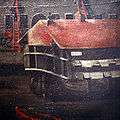French ship Duquesne (1813)
 Scale model of the Duquesne, on display at the Musée de la Marine in Toulon | |
| History | |
|---|---|
| Name: | Duquesne, Zélandais |
| Namesake: | Abraham Duquesne, Zealand |
| Builder: | Cherbourg |
| Laid down: | 1 October 1810 |
| Launched: | 12 October 1813 |
| Commissioned: | 30 June 1814 |
| Struck: | 19 November 1836 |
| General characteristics | |
| Class and type: | Bucentaure-class |
| Type: | ship of the line |
| Length: |
|
| Beam: | 15.27 m (50.10 ft) |
| Depth of hold: | 7.63 m (25.03 ft) |
| Propulsion: | Sail |
| Sail plan: | 2,683 m2 (28,879.57 sq ft) |
| Complement: | 801 (in 1814) |
| Armament: |
|
The Duquesne was an 80-gun Bucentaure-class 80-gun ship of the line of the French Navy, designed by Sané.
Built on brand new docks as Zélandais, she was renamed Duquesne following the Bourbon Restoration, on 27 April 1814, while she was still being commissioned. On 23 March 1815, during the Hundred Days, she was renamed Zélandais, and then Duquesne again on 15 July when Louis XVIII returned on the throne.
She took part in the Invasion of Algiers in 1830 under Captain Bazoche.
After the July Revolution, she was again renamed Zélandais.
On 24 January 1834, she ferried survivors of the wreck of Superbe to Toulon.
She was again used as a troopship, was used as a hulk in 1832 in Brest, and was eventually struck in 1836.
The figurehead of Duquesne is on display at the Musée national de la Marine in Paris. An oil painting in Brest naval museum shows Duquesne as a hulk during the fire of the harbour.
-

Figurehead of Duquesne, on display at the Musée national de la Marine in Paris.
-

Incendie de la salle d'armes à Brest le 25 janvier 1832
-

Incendie de la salle d'armes à Brest le 25 janvier 1832 (detail)
References
- Jean-Michel Roche, Dictionnaire des Bâtiments de la flotte de guerre française de Colbert à nos jours, tome I